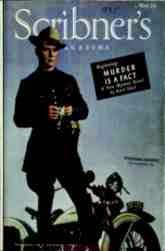~ Fast Company by Marco Page:
. . . Fast Company tears aside the curtain from the last scene in the world where one would expect murder to be rampant—the rare book business. . . . [See more HERE.]~ The Case of the Substitute Face by Erle Stanley Gardner:
. . . There is a zip and zest to the story that place it among Mason's best cases, and the Gardner formula, though not strikingly changed, is here all furbished up till it shines. . . . [More about Gardner HERE.]~ The Dead Don't Care by Jonathan Latimer:
. . . His new one is not his best. Too much Minsky and not enough mystery. . . . [See HERE for more about the author.]~ Cradled in Murder by Rudd Fleming:
. . . It has a certain horrid fascination, is definitely for those with strong stomachs, and would have been much better had the author scrapped the final scene, a psychopathic orgy that would have made Herr Kraft-Ebing dance for joy.~ To Wake the Dead by John Dickson Carr:
. . . Mr. Carr's uncanny talent for sending tremors racing up and down the vertebrae has never been better displayed, and Dr. Fell booms and blusters in fine style. . . . [See another review HERE.]~ Death Wears a White Coat by Theodora DuBois:
. . . The tale waxes somewhat heavily scientific at times but not enough to retard the action. . . . [There's more about Theodora HERE.]~ Truth Comes Limping by J. J. Connington:
. . . Mr. Connington is one of the better British practitioners of the mystery story, but in this yarn, not only truth, but the tale itself limps. . . . [Read more about this "practitioner" HERE.]~ If I Die Before I Wake by Sherwood King:
. . . From this neat beginning the story progresses through two more murders, considerable emoting, and a good trial scene, to a last-minute reprieve in the death house—for a reason the reader is not likely to guess. . . . [Orson Welles used this book as a starting point for his film The Lady from Shanghai (IMDb).]~ Curious Happenings to the Rooke Legatees by E. Phillips Oppenheim:
. . . very slight fare. . . . [A bibliography of Oppenheim's works is HERE.]~ Friday Market by Catherine Meadows:
. . . In writing it's decidedly a cut above the average. . . .~ Murders Not Quite Solved! by Alvin F. Harlow:
. . . Mr. Harlow has ransacked the annals of American crime—there is only one foreign case—for a dozen murders, famous in their day, that, for one reason or another, have fallen short of a final solution. . . .Resource:
- The full reviews which came from the May 1938 issue of Scribner's are HERE (2 pages).
Category: Detective fiction criticism









.jpg)
























